JHP Newsletter - 2013, No. 3, 5 July
Greetings from near Franktown, Colorado. I've had a fantastic time in Yellowstone National Park for more than a month.
Equipment: Canon EF 600mm f4 L IS II USM
Because I wasn't happy with the images from the Canon EOS 7D, I sold it and it was one of the most cost effective camera ownerships I've ever had. I purchased it used on eBay this past January and sold it on eBay in April and it cost me a whopping $16, plus shipping, to own it. I wish all of my camera bodies were that cheap!
Because I still wanted more reach than my Canon EF 500mm f4 L IS USM and Canon EOS 1D Mark IV with its 1.3x magnification factor, I rented a Canon EF 600mm f4 L IS II USM from Lens Rentals for the second week of my visit to Yellowstone. The Mk II versions of the 500 f4 IS and 600 f4 IS lenses are significantly lighter than their predecessors, so much so that the 600 f4 IS II weighs just 0.14 lb (50g) more than the 500 f4 IS (I). One of the biggest draws for me is the improved image quality, even with the 2x III tele-extender. Being able to have an effective 1200mm f8 lens would be great, and I wanted to see if the image quality would be acceptable. I also wanted to make sure that the physically larger lens would work with my lens cases and such. The 600 f4 IS II is 1.5 in longer and about an inch bigger in diameter than my 500 f4 IS.
Well, when I picked up the rental 600 f4 IS II, it was love at first touch. The build quality is superior to my 500 f4 IS and the manual focus is silky smooth. The focus is fast and the IS is quick to activate. Most importantly, images with the 600 f4 IS II and 2x III are about as sharp in the center as those with the 500 f4 IS and 1.4x III — amazing! I was able to accommodate the increased physical size and fell in love with the added flexibility of having a 600mm f4, an 840mm f5.6, and a 1200mm f8 lens and ordered one for my very own.
When I picked up my Canon EF 600mm f4 L IS II USM, I promptly removed the stock tripod foot so I could install a Lens Coat. It's the first time I've used a Lens Coat, but decided to go with it because it would be easier to install than my usual wrap-your-own using McNett Camo Form. The Forest Green Camo that I have is a bit dark, and I think the lighter tonality of the Realtree Max 4 might be better. However, almost everyone in Yellowstone has the Realtree Max 4 pattern and I'm a bit of a contrarian. Then I installed a Really Right Stuff replacement foot. It includes an integral Arca-Swiss plate and provides a lower-profile mounting solution than using an Arca-Swiss plate attached to the stock foot. The Really Right Stuff foot is really the right stuff for this lens because the Arca-Swiss plate extends towards the body enough to balance the lens on a Wimberley Head with a 2x III and a 1D X. The Kirk replacement foot has a similar shape as the stock foot and doesn't extend far enough towards the body. The Wimberley replacement foot would also provide a good balance, but the Arca-Swiss plate is so close to the lens that it can't be used as a handle. I also use a Don Zeck lens cap to keep the size of the lens as small as possible when packed because it doesn't add anything to the diameter of the lens like the stock Canon lens sock does.
After using the Canon EF 600mm f4 L IS II USM for about a month, I'm amazed at how many more high-quality images I'm able to make because being able to use the 2x III tele-extender really increases the reach. I sure wish I had purchased this lens instead of the Canon EOS 7D before going to Africa because I look back on opportunities that were missed because the 7D had such limited higher-ISO performance compared to even the 1D Mk IV.
Technique: Back Button Focus
Most cameras activate autofocus when the shutter is depressed half way. That's great as long as you can place a focus point on the subject when it's composed as you'd like, but not so good if you can't. I've occasionally run into problems where the autofocus points aren't close enough to the corner to compose an image exactly as I'd like, but lately I'd been really constrained by using the 600 f4 IS II and 2x III because only the center focus point of the 1D X works with a lens/teleconverter with a maximum aperture of f8. This is true for all Canon 1-series bodies and the 5D III. Other Canon bodies can't autofocus at all when the lens/teleconverter has a maximum aperture of f8.
Lots of nature photographers use back button focus, or rear focus, to overcome this problem. Instead of autofocus activating when the shutter is depressed half way, autofocus is activated by one of the buttons on the back of the body usually near where your thumb naturally rests. To take a picture of a stationary subject, or one that's mostly moving in the plane of focus, you place any active focus point on the subject, hit the rear button to activate autofocus, release the rear button to lock focus, compose the shot, then hit the shutter release. For a subject that's moving towards or away from the camera, and the camera's in AI-Servo (Canon) or AF-C (Nikon) mode, keep an active focus point on the subject and continue to hold the rear button down while activating the shutter.
Back button focus is also a great way to effectively instantly switch between AI-Servo (Canon) or AF-C (Nikon) and One-Shot (Canon) or AF-S (Nikon) and even manual focus modes if the camera/lens is set to AI-Servo (Canon) or AF-C (Nikon). By continuing to hold the back focus button, the focus will act like AI-Servo (Canon) or AF-C (Nikon) mode. By pressing and releasing the back focus button, the focus will act like an improved One-Shot (Canon) or AF-S (Nikon) mode. By ignoring the back focus button, it will act like manual focus.
I tried back button focus years ago and couldn't get the hang of it, so I returned to the traditional shutter button focus. However, now with the 600 f4 IS II and 2x III, I've set up my 1D X and 1D Mk IV for back button focus. In fact, I actually programmed the 1D X so both the AF-ON and * buttons activate focus because the AF-ON button is a bit far from my natural thumb position when using the vertical grip and I had previously programmed the * button to be inactive instead of exposure lock.
Travel: Yellowstone National Park
Jan and I went to Yellowstone National Park in the middle of May and stayed for a month because the animals were so cooperative. That's a great time to be in the park because the bears are starting to get really active and the crowds haven't arrived yet. This year wasn't as good as pervious years for grizzly bears, but I was able to get a couple of nice shots. One was of an adult crossing a sagebrush plane (below left) and one was of three spring cubs posing quite nicely (below right). The cubs are wet because it had been snowing heavily earlier in the morning.
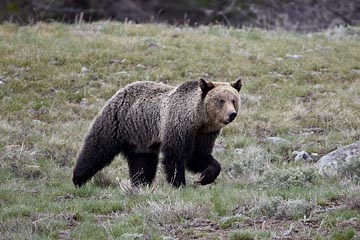
1/350 sec, f5.6, ISO 400
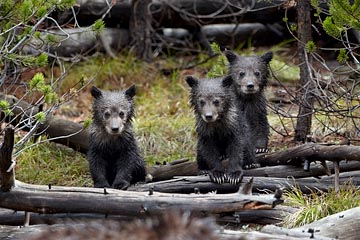
1/350 sec, f5.6, ISO 400
Black bears were quite predictable and provided many photo opportunities. Two of my favorite bears were a sow with a spring cub. The cub was just so cute and playful. My favorite image of them is when they crossed an open area after crossing the road (below left). Another favorite set of bears was a sow with two cinnamon yearling cubs. One of the cubs is nursing in the image below right.
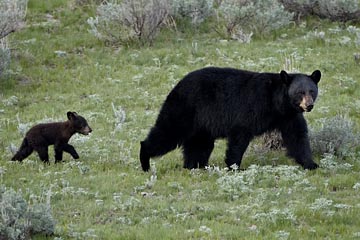
1/250 sec, f6.7, ISO 800
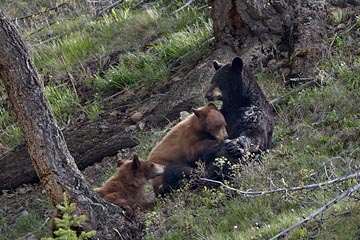
1/500 sec, f5.6, ISO 500
One of the most exciting black bear encounters was of an older adult, probably a boar, that I followed, or actually led, for almost a mile (1.5km) as it walked parallel to the road about 20-30 yds (20-30m) out. I photographed it from the car and stopped to be in position when it came towards me through an open area then I'd move down the road to shoot it again at the next open area. Fortunately, everyone else following the bear was using a short lens or point-and-shoot, so they were quite happy to stay roughly even with the bear which gave me an unobstructed view with a great angle.
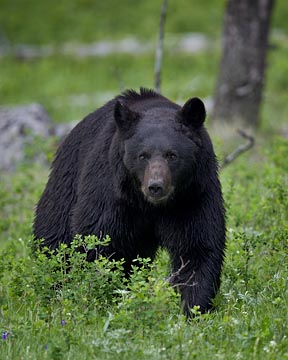
1/350 sec, f5.6, ISO 800
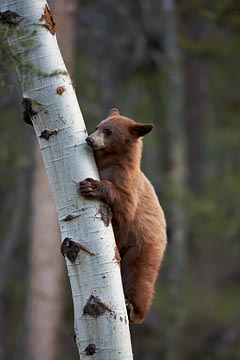
1/750 sec, f4, ISO 1250
Black bears are great tree climbers, as one of the cinnamon yearling cubs is demonstrating on this aspen tree (above right).
One of the highlights of the trip was photographing a red fox den. The den area was signed off to prevent people from getting too close, and this setting is what prompted me to rent the 600 f4 IS II so I would have some more reach. The vixen hung around the den most of the time to keep an eye on the two kits and the dog (adult male) was usually out hunting or otherwise hanging out in his man cave. One morning, the vixen started to hunt a small bird that had landed nearby, and I was able to capture the bird escaping at the last minute as the vixen charged (below left). The kits were quite playful and provided lots of opportunities for action shots, including this one of a surprise attack (below right).
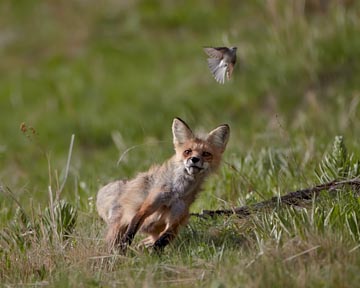
1/1500 sec, f5.6, ISO 500
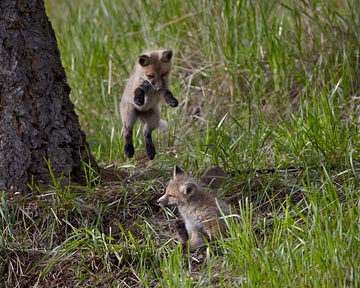
1/750 sec, f5.6, ISO 400
The dog was quite attentive and affectionate, when he was around, as show below left. The parents were starting to teach the kits to be interested in prey, and in the image below right the vixen is playing tug-of-war with one of the kits using a dead Uinta ground squirrel.
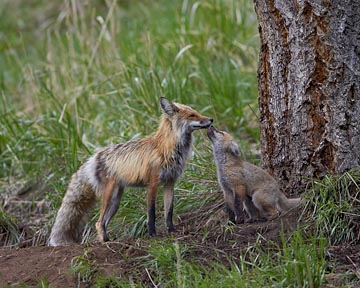
1/750 sec, f5.6, ISO 1000
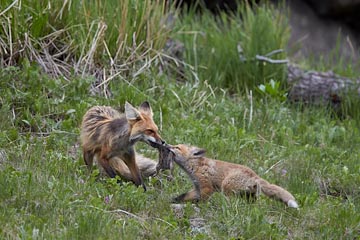
1/750 sec, f5.6, ISO 640
The story of the fox kits didn't have a happy ending. A badger came and took over the main den with the kits still in it, but the kits were able to escape out a back entrance and then moved into a nearby den. The adults kept vigil on the old den to try to drive away the badger when it came out. Unfortunately, after the dog had been out hunting for a long time, the vixen also left the den area and the badger took the opportunity to come out unmolested. It easily picked up the scent to the new den and took it over. There was no back entrance for the kits to escape, and that was the end of the kits.
Yellowstone is a great place to see wolves, but photographing them isn't always easy because they're usually so far away. I had four close-enough encounters with wolves, and two were quite good. One was when a wolf, 889F of the Junction Butte Pack, crossed the road about 100 yds (65m) ahead of me and I was afraid I had missed a great shooting opportunity as I continued driving down the road to where she had crossed. When I arrived, she was about 70 yds (65m) away and had just started to turn and head 45 degrees from the road. I turned around so I could photograph from the car and she started to run more or less perpendicular to me as she headed back towards the road in the direction I was now heading. Then I moved down the road and stayed ahead of her and stopped a few times to get some nice images. Then she went down into the deep depression with the Little America pond and I set up to photograph her where she would come up the hill back to the road level. I had time before she reached that point and noticed that there was a small hill just slightly further down the road that would be a great location for her to be when I photographed her. So, I moved down the road maybe another 20 yds (20m) to get ready for the great shot. I wouldn't have a shot until she crested the hill, and I couldn't even see her anymore. It's not a good feeling to loose sight of a rare subject, so I waited nervously hoping that my gamble to pass on some not-so-interesting record shots in favor of a killer shot would pay off. After a while, her head became visible behind the hill where I wanted to photograph her. A few seconds later and she was up on the top of the hill in a great location — bingo! I was one happy camper!
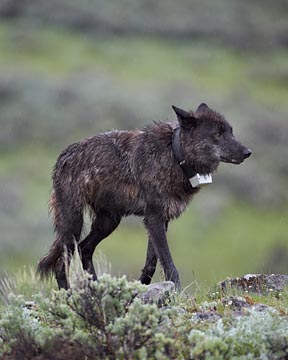
1/350 sec, f5.6, ISO 500
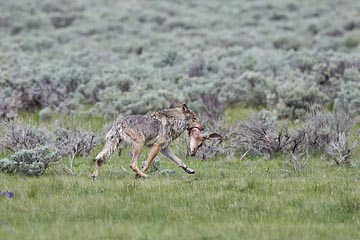
1/2000 sec, f8, ISO 640
The other great wolf encounter occurred near the confluence of Soda Butte Creek and the Lamar River. One of the uncollared wolves from the Lamar Canyon Pack was at an elk calf kill not too far from the road. After it finished eating where the body was located, it went to the sagebrush where it had hidden the elk calf's head, picked it up, then started carrying it away (above right) and probably back to the den.
One of the most unexpected subjects I photographed was a prairie falcon with a Uinta ground squirrel (below left). It was in the nicely-manicured lawn across from the Mammoth Visitor Center and was fairly comfortable with lots of photographers surrounding it. I sure wish I had had the 600 f4 IS II for this subject because the 2x III would have been most helpful to get some more reach. Another unusual subject was a river otter at Trout Lake (below right). Usually they're more common towards the end of June when the cutthroat trout spawn, but the otters were hanging around there even in early June.
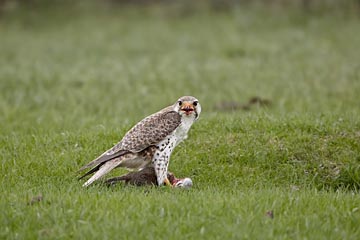
1/750 sec, f5.6, ISO 400
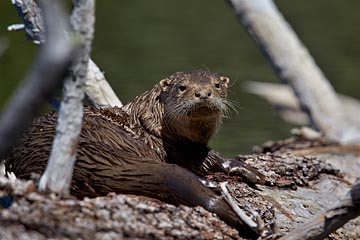
1/750 sec, f8, ISO 320
Spring is time for babies of all sorts, and I was really excited to be able to photograph a moose cow and a days-old calf in a decent setting one morning (below left). Another morning a pronghorn cow and calf were in a great location (below right).
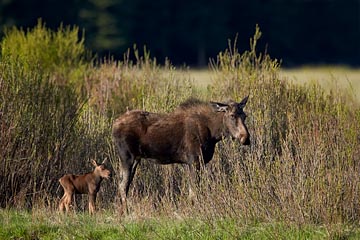
1/1500 sec, f8, ISO 1000
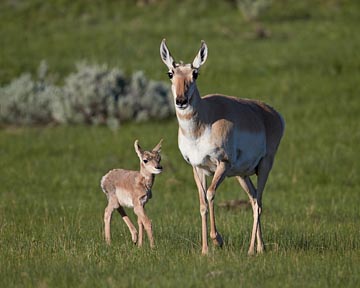
1/1000 sec, f8, ISO 400
I love to photograph ground squirrels, especially when they're in a great location like this Uinta ground squirrel among Mountain Bluebell (below left). Badgers were much more common this year than in past years, and we had several good opportunities to photograph them. This one (below right) was hunting ground squirrels, and it wasn't the one that had killed the fox kits.
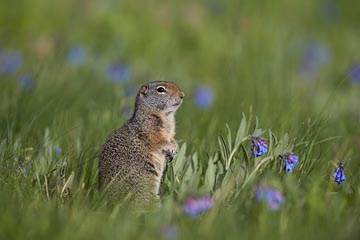
1/1500 sec, f8, ISO 640
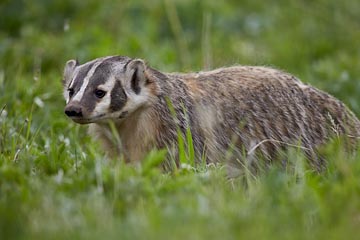
1/1500 sec, f5.6, ISO 640
I really focused on mammals this trip, but did spend some time at a mountain bluebird nest and was quite happy when the female poked her head out when the male was perched at the entrance (below left). We also spent one afternoon photographing wildflowers, and my favorite image is of a cluster of Alpine Shooting Star blooms (below right).
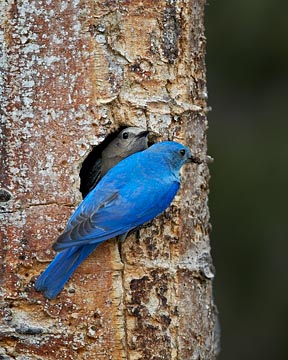
1/1000 sec, f8, ISO 1250
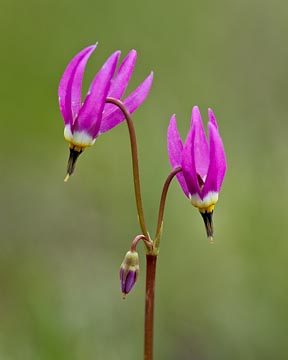
1/20 sec, f5.6, ISO 100
Towards the end of our stay, we found a great gray owl nest after getting a great tip from a photographer friend. The chicks were really small and I didn't get enough of them, so after leaving the park for about ten days, I returned in late June for four more days and I was so glad I did. The chicks had grown considerably during my absence and were much more active. I was also able to get a nice shot of one of the adults, probably the mother, leaving a nearby perch (below left). One of my favorite shots of the owls is of the mother with a vole in her beak at the nest with the older, approximately 24 day old, chick looking on. The mother didn't feed the older chick, and instead only fed the younger, maybe 21-22 days old, chick and I was really surprised that the older chick just sat there and didn't fight for any of the food.
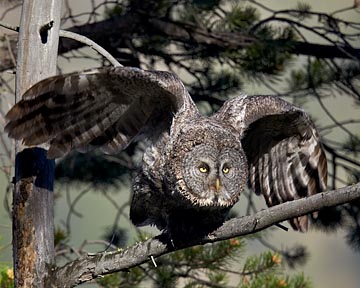
1/1000 sec, f8, ISO 1000
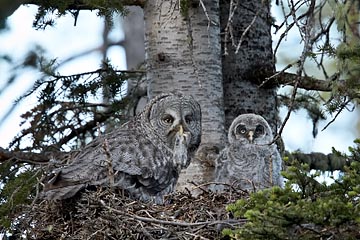
1/180 sec, f8, ISO 1600
While I was back, I also photographed the black bear spring cub who had also grown quite a bit (below left). The young Uinta ground squirrels had come out of their burrows and I had a great time photographing them one evening at the Soda Butte Picnic Area (below right).
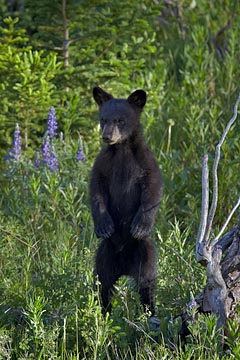
1/500 sec, f8, ISO 1000
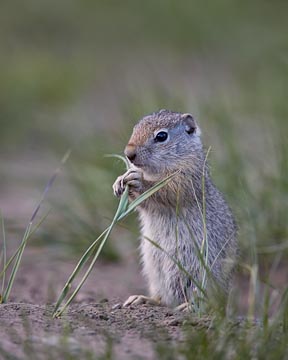
1/750 sec, f5.6, ISO 1250
Travel: Stillwater County, Montana
In addition to Yellowstone, I also did just a little photography on a private ranch in Stillwater County, Montana. Jan's brother Jay is friends with the ranch manager and we've been fortunate to visit the ranch several times. We've seen mule deer, white-tailed deer, wild turkey, and this year a golden eagle chick! When we visited the nest the first time on May 17th on our way to Yellowstone, the chick wasn't much more than a ball of white down, but it was starting to walk unsteadily around the nest, so it was about 15-18 days old (below left). We visited the nest again on June 17th and 18th after visiting Yellowstone, and it was amazing how much the chick had grown! It was much more active than on our previous visit, and it seemed to like being behind the large branch between us and the nest, probably because that provided some shade and also privacy from the paparazzi. In the image below right it's about 47-50 days old and will likely fledge between 66 and 75 days old.
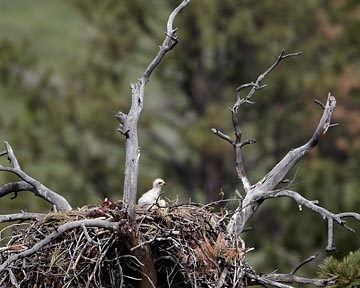
1/2000 sec, f5.6, ISO 250
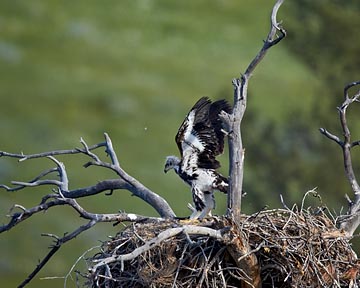
1/750 sec, f8, ISO 640
Later today I'll be heading to Iceland for about a month and I'll tell you all about it next time.
Take care and happy shooting.
— James
James Hager Photography :: www.jameshagerphoto.com




